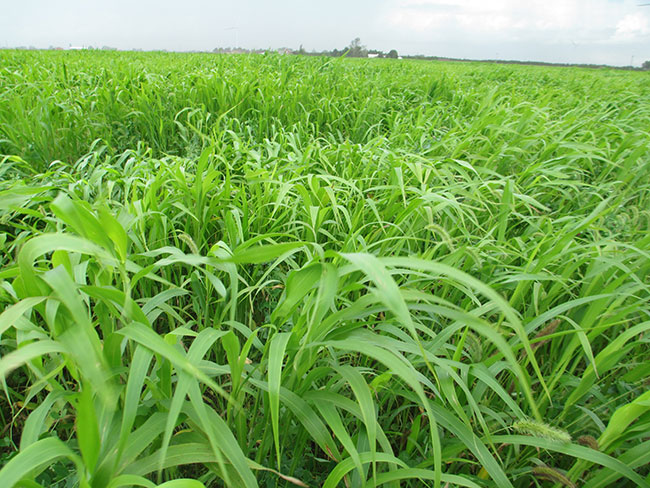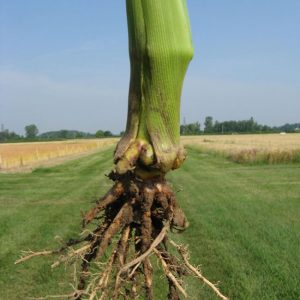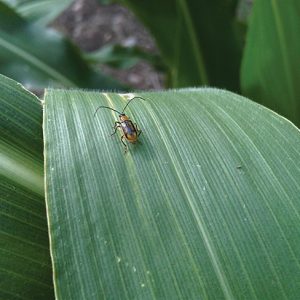
Features
Insect Pests
Safeguarding BT rootworm traits
An innovative rotation alternative to silage corn can clobber Bt-resistant rootworms while providing good silage yields.
December 14, 2020 By Carolyn King
 Christine O’Reilly suggests a double-crop rotation option that includes sorghum-sudangrass instead of silage corn. Photo courtesy of Christine O’Reilly, OMAFRA.
Christine O’Reilly suggests a double-crop rotation option that includes sorghum-sudangrass instead of silage corn. Photo courtesy of Christine O’Reilly, OMAFRA.
A troubling trend emerged in some Ontario corn-growing areas in 2020. “[In several counties,] we have seen concerning levels of corn rootworm injury for all of the Bt rootworm hybrids, even the pyramid hybrids. Those injury levels make us think the rootworms are likely resistant to them,” says Tracey Baute, field crop entomologist for the Ontario Ministry of Agriculture, Food and Rural Affairs (OMAFRA).
“This Bt resistance problem will not go away unless we take mitigation measures. Even if growers have not experienced rootworm injury to a significant level yet, they will over time if we aren’t able to reduce this resistant population now. In one to three years, they could start to see serious yield reductions and other impacts of corn rootworm, like corn flattened in windstorms, goosenecking and root injury,” she notes.
“Now is the best time we have to manage this issue before you can no longer use Bt corn at all for rootworm protection.”
Baute and her colleagues are working on practical options for growers to really reduce Bt-resistant rootworm populations in 2021.
The 2020 situation
Clusters of fields in the counties of Huron, Perth and Durham were identified in 2020 as having rootworm injury to Bt rootworm hybrids. Baute and other members of the Canadian Corn Pest Coalition suspect that Bt-resistant rootworm populations are likely present in these fields and in other regions of Ontario where continuous corn is common and where growers have tended not to rotate their Bt traits.
However, Baute notes that the lab bioassays to confirm Bt resistance will take months to complete, and some of the results may not be made public. “The corn companies are not required to disclose the results directly to us, just to the Canadian Food Inspection Agency. Some of the bioassays are done through the companies, and others choose to have the bioassays publicly done at the University of Guelph’s Ridgetown campus,” she says.
“Through public testing, we know of one field that was confirmed to have Bt-resistant rootworms in 2019.” That field had resistance to Cry3Bb1, one of four available Bt rootworm proteins. The others are Cry34/35Ab1, mCry3A, and eCry3.1.
Nowadays, many Ontario corn hybrids have two of these four proteins, but sometimes these pyramid hybrids do not provide as durable rootworm protection as one might hope for.
“When these rootworm traits first came out, they were only single traits in the hybrids. So growers grew corn-on-corn with single-trait hybrids [resulting in development of some resistance in the rootworm population]. Then pyramid hybrids came out with two rootworm traits. But the first trait that had been used for so long was part of that pyramid. It is no longer really a pyramid hybrid if the local rootworm population has already developed resistance to one of the two traits in the pyramid,” Baute explains.
“On top of that, these Bt rootworm traits are closely related to each other, so there is a tendency for cross-resistance to occur.” In other words, a rootworm population with resistance to one Bt trait may also have resistance to others.
The 2020 observations of possible issues with all four rootworm proteins are very worrisome. Continuing to grow Bt rootworm hybrids in the affected fields could allow the resistant populations to survive, thrive and spread as the resistant beetles fly to nearby corn fields to lay their eggs.
Baute notes, “Corn growers in the U.S. have been dealing with Bt rootworm resistance for about a decade. We definitely don’t want to be in that scenario. We have a chance now to fix the problem.”
Rotation is the best option
“If you have seen significant rootworm injury on your Bt rootworm hybrids, the number one very best option is to rotate out of corn,” Baute emphasizes. That’s because corn rootworm larvae must have corn roots to feed on in order to survive.
“The adult beetles lay their eggs in a corn field in the summer. Those eggs overwinter, and the larvae come out in the spring. The larvae can’t move very far in the soil, so if there are no corn roots to feed on in that field, the larvae will starve to death.”
Rotating out of corn for one year is great for Bt-resistant rootworm control, and two years would be even better. “Rotating out of corn for two years would really knock back any lingering rootworm populations that found corn somewhere in the area to sustain themselves,” she explains. “One factor is that, even if one grower rotates out of corn, nearby fields may still have corn, helping to sustain the resistant rootworm population. Another factor is that we have potential at a very low level to have the rotation variant of rootworms.” This variant develops in regions where two-year corn rotations, typically corn-soybean rotations, have been used for many years. The variant females lay their eggs in nearby non-corn fields so the larvae will be emerging in the corn year of the rotation.
Baute and her colleagues want to offer growers good alternatives to corn. “We are working on silage alternatives, grain feed alternatives, cash crop alternatives – anything that is not corn is a better option to significantly knock back this resistant population.”
Christine O’Reilly, OMAFRA’s forage and grazing specialist, has been brought on board to help with this. She says, “Corn is commonly grown as silage and grain for livestock feed, and I am working on finding options for livestock producers to replace silage corn in their rations.”
However, finding silage options that are as good as corn is a tall order.
“One of the reasons why corn is popular as a forage crop is that it has such a high yield potential. Even though corn is expensive to grow on a per acre basis, the cost per tonne is very low because the yield potential is so high,” O’Reilly says.
“But if producers don’t rotate out of silage corn to reduce corn rootworm populations, we will see silage corn yields drop quickly [and rootworm management costs increase]. We could soon reach a point where silage corn is no longer economical on a per tonne basis.”
O’Reilly adds, “The other reason corn is so popular as a feed crop is that it is very forgiving in terms of the harvest window. Ideally, corn silage should be harvested at 65 per cent moisture content, give or take a couple percentage points depending on the type of silo. But sometimes the weather will delay harvest, or a custom contractor can’t make it to the field exactly when the crop is ready, so the corn is ensiled when it is a couple of percentage points drier than ideal. Slightly dry corn silage won’t ferment as efficiently and we get more shrink, which is an ‘invisible’ loss – a loss that is hard to measure and that people may be less aware of. However, the quality of that feed remains very high because there is so much starch in corn silage.”
An innovative double-crop rotation option
By digging into the existing research on silage crops, O’Reilly has already identified one good rotation alternative to silage corn.
“To replace silage corn, we need something that can deliver a similar yield and not be a host for corn rootworm. A double-cropping option of a winter cereal, either fall rye or winter triticale, followed by sorghum-sudangrass ticks both of those boxes,” she says.
“U.S. research on potential host crops for corn rootworm has found that winter cereal roots won’t support corn rootworm larvae. And forage sorghum, sorghum-sudangrass and sudangrass produce a compound called dhurrin when they are stressed [including stress from insect feeding]. This compound will poison the corn rootworm larvae. So these crops are not rootworm hosts and will help knock back the corn rootworm population.”
Just as important, this double-crop combo is one of the few options that equals the yield potential of a silage corn crop. O’Reilly says, “Individually, neither one of these crops could fill the silo to the same extent as corn. But by combining them into that double-crop system, in a 12-month period we can get as much forage as we could from growing a crop of corn.” However, she adds, “Producers should be aware that this double crop does not contain as much energy as silage corn. Energy will have to be supplemented to balance the ration.”
Winter triticale and fall rye are both fast-growing winter cereals with high yield potentials. “Tom Kilcer in New York State has been doing a lot of research on double cropping to increase silage production per acre overall, particularly with a winter cereal followed by a short-season silage corn crop. He has found better yields and better forage quality with winter triticale. A bit of research in Ontario found that we have better yields with fall rye, although it’s not a huge difference. So either of those crops could work for getting forage over the winter.”
She points out another advantage of this double-crop option: “These crops can be planted and harvested with conventional forage equipment – grain drill, mower, rake, and baler – so most farms are equipped to grow them.”
To implement this double crop, you would plant either fall rye or winter triticale in the fall right after harvesting silage corn. “The optimum planting date is about 10 to 14 days before the optimum seeding date for winter wheat as a grain crop. The earlier planting date is so that those plants have a chance to tiller because, in a forage situation, it is really those tillers that produce yield,” she explains.
“The winter cereal will be ready to be harvested as baleage or silage between mid-May and the end of May. Then, after tillage or burndown to terminate any regrowth of the winter cereal, the sorghum-sudangrass is planted in early June. You can take two cuts of this crop.”
O’Reilly offers some tips to growers who are new to these silage crop options. “Good agronomy is important, so pay attention to basic things like seedbed prep and fertility. Seeding rate is something to watch; these crops are often used as cover crops, which are sown at a lighter rate than a forage crop,” she says.
“The biggest challenge is correctly timing harvest. Unlike corn, these crops lose quality very quickly once they get past the ideal harvest stage. For the cereals, producers should cut them between flag leaf and boot stage for maximum quality. Sorghum-sudangrass needs to be cut before it heads out. Both the cereal and the sorghum-sudangrass are wilted to the target moisture content for ensiling or baleage. If they are not cut at the ideal stage, lignin increases quickly, digestible fibre and protein content decrease rapidly, and producers will be disappointed with the quality of the feed.”
If rotating out of corn is not an option
If you have Bt-resistant rootworms, but you have to produce corn, Baute recommends several tactics to help fight the pest.
“That corn should be pyramided for Bt rootworm traits. Even though you will see some rootworm injury, you will at least set back some susceptible individuals in the population. You could also plant a non-rootworm Bt hybrid and apply a granular insecticide to protect the corn from rootworm,” she says.
“However, those insecticides only protect the crop; they don’t knock back the rootworm population. So we’re also encouraging growers to use nematodes for rootworm biocontrol. That way, you are actually knocking back the resistant population.”
Baute explains, “Elson Shields’ lab at Cornell University produces certain nematode species for insect biocontrol. They have successfully shown many times that if we apply these nematodes on fields, the nematodes will control any surviving rootworms. It takes time for the nematodes to get going, so you’ll need to also apply an insecticide in the first year. But the nematodes are persistent – if you apply them in one year, that population will sustain itself and help control rootworms for years to come.”
According to Baute, this biocontrol treatment would cost about $50 per acre. The ideal application window is between pre-planting and V4. “The nematodes can be applied using a sprayer with the screens and filters removed and slightly reconfigured nozzles. As long as you get the product out of the tank within about half an hour, the nematodes have good success in establishing in the soil. The U.S. research also shows you can apply the nematodes in manure. We are willing to try and see if that approach will work here too.”
This treatment also controls some other insect pests in the soil, and research so far shows the nematodes are safe for plants, humans and beneficial insects. Baute says the nematode species used by Cornell also occur naturally in Ontario, so they can be shipped from New York and applied on Ontario fields without any special requirements.
Baute, O’Reilly and their colleagues are continuing to look for other possible rotation options and management measures for Bt-resistant rootworms. They will be developing guidelines for 2021 so growers can safeguard Bt rootworm traits, keep corn as a viable silage option, and trounce this major crop pest.

